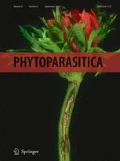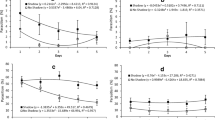Abstract
This study aimed to verify the preference and infestation level of Anastrepha fraterculus (Diptera: Tephritidae) [South American fruit fly] in fruits of guava cultivars and to correlate them to variables such as peel coloration, soluble solids and pH of fruit cultivars. The following cultivars were used: Pedro Sato, Paluma, Cascão and Século XXI. The infestation was evaluated in cages, considering two scenarios: no-choice and multiple choice. In both tests, evaluations of the fruit attraction to insects were conducted for a period of 1′, 3′, 5′, 10′, 20′, 30′, 1 h, 2 h, 6 h, 12 h and 24 h. The visit of A. fraterculus on the assayed cultivars in relation to the time was studied by logistic regression. After 10 days, the number of larvae in each fruit was recorded. In the multiple choice test, the visit proportions were significantly higher in the fruits of cvs. Século XXI and Pedro Sato than in those of cvs. Paluma and Cascão. In the no-choice test, the visit proportions were significantly lower in the Paluma fruits. In both tests, the rate of fruit infestation by A. fraterculus did not differ among cvs. Pedro Sato, Paluma and Cascão, whereas the fruits of cv. Século XXI were more infested. The indexes of pH did not interfere with the infestation of A. fraterculus, whereas a high rate of soluble solids and low color angle appear to be crucial for discriminating the fruits of the most susceptible cultivars. Infestation rate of Século XXI fruits displayed significant correlations with: °Brix (r= 0.7078) and color angle (h) (r= –0.9499) of guava fruits under the multiple choice conditions.









Similar content being viewed by others
References
Aluja, M., Piñero, J., Jácome, I., Díaz-Fleischer, F., & Sivinski, J. (2000). Behavior of flies in the genus Anastrepha (Trypetinae: Toxotrypanini). In M. Aluja & A. L. Norrbom (Eds.), Fruit flies (Tephritidae): phylogeny and evolution of behavior (pp. 375–410). Boca Raton, FL, USA: CRC Press.
Anon. (2009). Anuário Brasileiro da fruticultura. Gazeta Santa Cruz, Santa Cruz do Sul, Rio Grande do Sul, Brasil.
AOAC. (1995). Official methods of analysis of the Association of Official Analytical Chemists. 14th ed. Washington, DC.
AOAC. (1997). Official methods of analysis of the Association of Official Analytical Chemists. 16th ed. Washington, DC.
Boiça Junior, A. L., & Campos, A. P. (2010). Resistência de plantas a insetos: ensino, pesquisa e extensão. In A. C. Busolli (Ed.), Tópicos em entomologia agrícola III. Jaboticabal, Sao Paulo, Brazil: Multipress.
Cavalcanti, A. L., Forte, K. O., Silva, P. P., Rabelo, M. V. D., Pereira, S. K. C., & Fernandes, F. V. (2006). Determinação dos sólidos solúveis totais (°Brix) e pH em bebidas lácteas e sucos de frutas industrializados. Pesquisa Brasileira em Odontopediatria e Clínica Integrada, 6, 57–64.
Cavalini, F. C., Jacomino, A. P., Lochoski, M. A., Kluge, R. A., & Ortega, E. M. M. (2006). Maturity indexes for ‘Kumagai’ and ‘Paluma’ guavas. Revista Brasileira de Fruticultura, 28, 176–179.
Cytrynowicz, M., Morgante, J. S., & Souza, H. M. L. (1982). Visual responses of South American fruit flies, Anastrepha fraterculus, and Mediterranean fruit flies, Ceratitis capitata, to colored rectangles and spheres. Environmental Entomology, 11, 1202–1210.
Díaz-Fleischer, F., Papaj, D. R., Prokopy, R. J., Norrbom, A. L., & Aluja, M. (2000). Evolution of fruit fly oviposition behavior. pp. 811–841. In M. Aluja & A. L. Norrbom (Eds.), Fruit flies (Tephritidae): phylogeny and evolution of behavior. Boca Raton, FL, USA: CRC Press.
Dukas, R., Prokopy, R. J., Papaj, D. R., & Duan, J. J. (2001). Egg laying behavior of Mediterranean fruit flies (Diptera: Tephritidae): is social facilitation important? Florida Entomologist, 84, 665–671.
El-Buluk, R. E., Babiker, E. E., & El Tinay, A. H. (1995). Biochemical and physical changes in fruits of four guava cultivars during growth and development. Food Chemistry, 54, 279–282.
Gorgatti Neto, A., Garcia, A. E., Ardito, E. F. G., Garcia, E. C., Bleinroth, E. W., Matallo, M., et al. (1996). Goiaba para exportação: procedimento de colheita e pós-colheita. Brasilia, Brazil: Embrapa/SPI.
Gould, W. P., & Raga, A. (2002). Pests of guava. In J. E. Peña, J. L. Shorp, & M. Wysoki (Eds.), Tropical fruit pests and pollinators: biology, economic importance, natural enemies and control (pp. 295–313). Wallingford, Oxfordshire, UK: CABI.
Gouveia, J. P. G., Almeida, F. A. C., Medeiros, B. G. S., Ribeiro, C. F. A., & Silva, M. M. (2003). Maturação da goiaba (Psidium guajava L.) mediante parâmetros físico-químicos. Revista Brasileira de Produtos Agroindustriais, 1, 85–94.
Gregorio, P. L. F., Sant’Ana, J., & Redaelli, L. R. (2010). Chemical and visual perception of Anastrepha fraterculus (Diptera, Tephritidae) in laboratory. Iheringia Serie Zoologia, 100, 128–132.
Lara, F. M. (1991). Princípios de resistência de plantas a insetos. São Paulo, Brazil: Ícone.
Lima, M. A. C., Assis, J. S., & Gonzaga Neto, L. (2002). Caracterização dos frutos de goiabeira e seleção de cultivares na região do submédio São Francisco. Revista Brasileira de Fruticultura, 24, 273–276.
López-Guillén, G., Valle-Mora, J., Cazares, C. L., & Rojas, J. C. (2009). Response of Anastrepha obliqua (Diptera: Tephritidae) to visual and chemical cues under seminatural conditions. Journal of Economic Entomology, 102, 954–959.
Lorscheiter, R., Redaelli, L. R., Botton, M., & Pimentel, M. Z. (2012). Caracterização de danos causados por Anastrepha fraterculus (Wiedemann) (Diptera, Tephritidae) e desenvolvimento larval em frutos de duas cultivares de quivizeiro (Actinidia spp.). Revista Brasileira de Fruticultura, 34, 067–076.
McGuire, R. G. (1992). Reporting of objective color measurements. Hort Science, 27, 1254–1255.
McInnis, D. O. (1989). Artificial oviposition sphere for Mediterranean fruit flies (Diptera: Tephritidae) in field cages. Journal of Economic Entomology, 82, 1382–1385.
Montes, S. M. N. M., & Raga, A. (2006). Eficácia de atrativos para monitoramento de Ceratitis capitata (Diptera: Tephritidae) em pomar de citros. Arquivos do Instituto Biológico, 73, 317–323.
Nufio, C. R., & Papaj, D. R. (2004). Superparasitism of larval hosts by the walnut fly, Rhagoletis juglandis, and its implications for female and offspring performance. Oecologia, 141, 460–467.
Oliveira, F. Q., Batista, J. L., Malaquias, J. B., Almeida, D. M. A., & Oliveira, R. (2010). Determination of the median lethal concentration (LC50) of mycoinsecticides for the control of Ceratitis capitata (Diptera: Tephritidae). Revista Colombiana de Entomologia, 36, 213–216.
Oliveira, F. Q., Malaquias, J. B., Figueiredo, W. R. S., Batista, J. L., & Beserra, E. B. (2012). Inhibition of fruit infestation by Mediterranean fruit fly using natural products. African Journal of Biotechnology, 11, 13922–13927.
Paiva, P. E. B., & Parra, J. R. P. (2013). Hidrogenionic potential (pH) of the attractant, trap density and control threshold for Ceratitis capitata (Diptera: Tephritidae) on Hamlin oranges in São Paulo central region, Brazil. Revista Brasileira de Fruticultura, 35, 464–470.
Papachristos, D. P., Papadopoulos, N. T., & Nanos, G. D. (2008). Survival and development of immature stages of the Mediterranean fruit fly (Diptera: Tephritidae) in citrus fruit. Journal of Economic Entomology, 101, 866–872.
Papadopoulos, N. T., & Katsoyannos, B. I. (2002). Development of Ceratitis capitata (Diptera: Tephritidae) in three apple varieties in the laboratory. In: B. Barnes (Ed.), Proceedings of 6th International Fruit Fly Symposium (pp. 19–22; Stellenbosch, South Africa). Isteg Scientific Publications.
Rattanapun, W., Amornsak, W., & Clarke, A. (2009). Bactrocera dorsalis preference for and performance on two mango varieties at three stages of ripeness. Entomologia Experimentalis et Applicata, 131, 243–253.
Renwick, J. A. A. (1989). Chemical ecology of oviposition in phytophagous insects. Experientia, 45, 223–228.
Salles, L. A. B. (1992). Metodologia de criação de Anastrepha fraterculus (Wied., 1830) (Diptera: Tephritidae) em dieta artificial em laboratório. Anais da Sociedade Entomológica Brasileira, 21, 479–486.
Santos, J. P., Corrent, A. R., Berton, O., Schwarz, L. L., & Denardi, F. (2008). Incidência de podridão-branca em frutos de macieira com e sem ferimentos. Revista Brasileira de Fruticultura, 30, 118–121.
SAS Institute. (2002). SAS/Stat users guide. NC, USA: Cary.
Scheirs, J. (2002). Integrating optimal foraging and optimal oviposition theory in plant–insect research. Oikos, 96, 187–191.
Silva, J. E. B., Dantas Neto, J., Gomes, J. P., Maciel, J. L., Silva, M. M. M., & Lacerda, R. D. (2008). Avaliação do ºBrix e pH de frutos da goiabeira em função de lâminas de água e adubação nitrogenada. Revista Brasileira de Produtos Agroindustriais, 10, 43–52.
Singer, M. C. (1986). The definition and measurement of oviposition preference in plant-feeding insects. pp. 65–94. In J. R. Miller & T. A. Miller (Eds.), Insect–plant interactions. New York, NY: Springer-Verlag.
Slansky, F. J. R. (1982). Insect nutrition: an adaptationist’s perspective. Florida Entomologist, 65, 45–71.
Thompson, J. N. (1988). Evolutionary ecology of the relationship between oviposition preference and performance of offspring in phytophagous insects. Entomologia Experimentalis et Applicata, 47, 3–14.
Thompson, J. N., & Pelmyr, O. (1991). Evolution of oviposition behavior and host preference in Lepidoptera. Annual Review of Entomology, 36, 65–89.
Vargas, R. I., Williamson, D. L., Chang, H., & Komura, M. (1984). Effects of larval-diet pH on worker comfort and insect quality during mass-production of Mediterranean fruit fly (Diptera: Tephritidae) in Hawaii. Journal of Environmental Science, 19, 621–630.
Zucoloto, F. S. (1993). Acceptability of different Brazilian fruits to Ceratitis capitata (Diptera: Tephritidae) and fly performance of each species. Brazilian Journal of Medical and Biological Research, 26, 291–298.
Acknowledgments
The English of this manuscript was revised by Academic Proofreading Services. We thank the Val Fruit Company for providing the cultivars of guava fruits and the Technology Laboratory of the Department of Agricultural Products Technology, Faculty of Agricultural Sciences and Veterinary (FCAV) - UNESP - Jaboticabal for making it possible to carry out physicochemical analyses on fruit. We would like to thank anonymous reviewers for their helpful comments on this work.
Author information
Authors and Affiliations
Corresponding author
Rights and permissions
About this article
Cite this article
de Oliveira, F.Q., Junior, A.L.B., Costa, M.d.L.Z. et al. Preference and infestation level of Anastrepha fraterculus (Wiedemann, 1830) on fruits of some Psidium guajava L. cultivars and relation to their physicochemical parameters. Phytoparasitica 42, 475–483 (2014). https://doi.org/10.1007/s12600-014-0384-7
Received:
Accepted:
Published:
Issue Date:
DOI: https://doi.org/10.1007/s12600-014-0384-7




